How Can Montessori Parent Education Enhance My Parenting Skills?
Montessori Parent Education can be important resource for parents, offering insights and strategies to improve their parenting skills. It provides a practical framework based on Montessori principles that promotes independence, effective communication, and problem-solving in children. By learning these techniques, parents can create a nurturing environment that supports their child’s development and fosters a strong parent-child relationship. Ultimately, Montessori Parent Education empowers parents to become more confident and effective in their role as caregivers and educators.
Montessori Parent Education can help you become a better parent in several ways:
Understanding Child Development
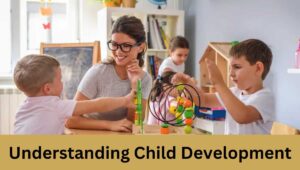
Montessori education is built on a deep understanding of how children grow and learn. By learning about Montessori principles, you can better understand what’s happening in your child’s mind at different ages and stages.
Encouraging Independence
Montessori focuses on teaching kids to do things for themselves. You’ll learn strategies to encourage your child to be more independent, which can make your daily life smoother.
Effective Communication
Montessori emphasizes respectful communication. You’ll learn how to talk to your child in a way that helps them feel heard and valued.
Creating a Learning-Friendly Environment
You’ll discover how to set up your home so that it’s conducive to learning and exploration. Montessori materials and activities can be used at home to stimulate your child’s curiosity.
Nurturing a Love for Learning
Montessori believes in making learning enjoyable. You’ll pick up ideas on how to instill a love for learning in your child, which can benefit them throughout life.
Problem-Solving Skills
Montessori teaches kids how to solve problems independently. You’ll learn techniques to help your child develop this crucial skill.
Conflict Resolution
Handling conflicts in a positive way is crucial in parenting. Montessori methods can teach you how to guide your child through disagreements constructively.
Practical Application
Montessori Parent Education isn’t just theory; it’s about applying these ideas in your daily life. You’ll discuss real-life situations and how to use Montessori principles to address them.
Resources and Support
You’ll gain access to helpful resources like books, articles, and websites. You may also find local Montessori parenting groups or workshops for ongoing support.
Connecting Montessori values to parenting skills
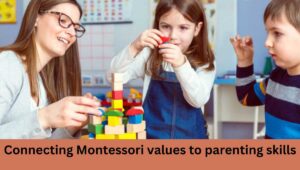
Respect for Independence
Montessori values the child’s independence. As a parent, you can support this by allowing your child to do things for themselves, like dressing or preparing snacks. This helps them feel capable and confident.
Creating a Learning-Friendly Home
Montessori classrooms are designed to encourage exploration and learning. At home, you can arrange toys and activities to stimulate your child’s curiosity and make learning fun.
Communication
Montessori teaches respectful communication. Instead of giving orders, you can talk to your child in a way that shows you value their thoughts and feelings. This helps them learn how to express themselves too.
Teaching Through Experience
Montessori believes in hands-on learning. You can apply this by letting your child explore and discover things themselves. For example, let them pour their own drink or plant a small garden.
Encouraging Problem-Solving
Montessori methods teach kids to solve problems independently. As a parent, you can guide your child through challenges rather than always solving them for them. This builds their problem-solving skills.
Patience and Observation
Montessori teachers observe children closely to understand their needs. You can do the same by being patient and paying attention to your child’s interests and development.
Grace and Courtesy
Montessori emphasizes good manners and consideration for others. You can teach these values at home, helping your child learn to be respectful and kind.
Order and Routine
Montessori environments are orderly and follow routines. Establishing routines at home can create a sense of security and help your child know what to expect each day.
Fostering Independence and Self-Discipline
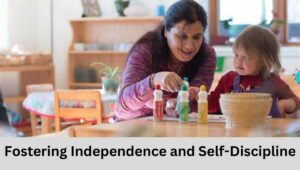
Independence
- Allowing Choices
Encourage your child to make small choices, like what to wear or which book to read. This helps them feel in control and capable.
- Doing Things Alone
Give them opportunities to do tasks on their own, such as getting dressed, setting the table, or tidying up their toys. Offer help when needed, but let them try first.
- Problem-Solving
When your child faces a problem, guide them in finding solutions rather than solving it for them. This helps them become resourceful.
- Building Confidence
Praising their efforts and achievements, even if they’re small, boosts their self-esteem and makes them more willing to try new things.
Self-Discipline
- Setting Limits
While encouraging independence, it’s also essential to set reasonable limits and boundaries. This helps your child understand what’s acceptable behavior.
- Consistency
Be consistent with rules and consequences. This teaches your child that actions have predictable outcomes.
- Modeling Behavior
Children learn by observing their parents. Demonstrate self-discipline and emotional control in your own actions.
- Teaching Patience
Help your child understand that they can’t always have what they want immediately. Delayed gratification is an essential skill.
Effective Communication
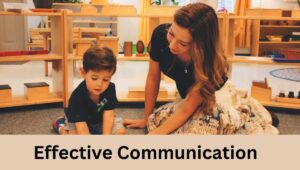
Listen Actively
- Pay full attention when your child is talking to you. This shows that you value what they have to say.
- Make eye contact and nod to show you’re listening.
- Avoid interrupting. Let your child finish speaking before responding.
Speak Respectfully
- Use a calm and gentle tone of voice. Avoid yelling or shouting.
- Speak to your child with kindness and respect, just as you’d like to be treated.
- Be mindful of your words and avoid hurtful or harsh language.
Encourage Expression
- Create an open and safe space for your child to express their thoughts and feelings.
- Let them know that it’s okay to share their emotions, even if they’re negative.
- Avoid judgment or criticism when they share their thoughts.
Ask Open-Ended Questions
- Instead of asking yes/no questions, ask open-ended ones that encourage conversation.
- For example, instead of “Did you have a good day at school?” you could ask, “What was the best part of your day at school?”
Empathize and Validate
- Show empathy by understanding and acknowledging your child’s feelings.
- For example, if they’re upset about something, you can say, “I can see that you’re feeling sad. Can you tell me what happened?”
- This helps your child feel heard and understood.
Be Patient
- Give your child time to express themselves, especially if they’re hesitant or need extra time to find the right words.
- Avoid rushing them or finishing their sentences.
Problem-Solve Together
- When conflicts or issues arise, work together with your child to find solutions.
- Encourage them to come up with ideas and discuss the pros and cons of each.
Positive Feedback
- Praise and encourage your child when they communicate well or express themselves effectively.
- Let them know that you appreciate their efforts.
Creating a Prepared Environment
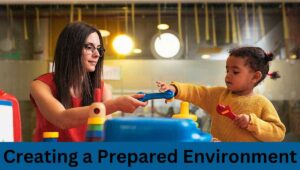
Order and Organization
- Keep your child’s space neat and organized. This makes it easier for them to find what they need and develop a sense of order.
Accessibility
- Arrange items in your child’s environment so that they can reach them independently. This encourages them to do things on their own.
Child-Sized Furniture and Tools
- Use furniture and tools that are the right size for your child. For example, provide a small table and chairs for them to eat or work at.
Materials and Activities
- Choose age-appropriate toys, books, and learning materials that match your child’s interests and developmental stage. Rotate these items to keep things fresh and engaging.
Safety
- Ensure that your child’s environment is safe. Remove any potential hazards, such as sharp objects or items they could swallow.
Independence Stations
- Set up specific areas for your child to do things on their own. For example, create a snack station with healthy snacks they can access themselves.
Freedom Within Limits
- Give your child some choices within reasonable limits. This helps them feel in control and responsible.
Calm and Peaceful Atmosphere
- Create a quiet and peaceful atmosphere in your child’s space. Avoid excessive noise or distractions.
Nature and Exploration
- Encourage your child to connect with nature by having plants or outdoor play spaces. Nature stimulates curiosity and learning.
Personalization
- Involve your child in personalizing their space. Let them choose colors, decorations, or pictures to make it their own.
Respect and Trust
- Show respect for your child’s choices and trust in their abilities. This boosts their self-esteem and confidence.
Problem-Solving and Conflict Resolution
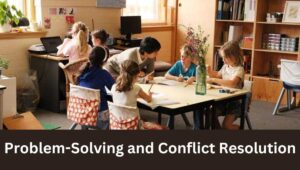
Define the Problem
- Start by identifying what the problem or conflict is. Help your child understand the situation clearly.
Stay Calm
- Encourage your child to stay calm and not get too upset. Explain that problems happen, and it’s okay.
Brainstorm Solutions
- Together with your child, come up with different ways to solve the problem. List all the ideas, even if some seem silly.
Evaluate Options
- Discuss the pros and cons of each solution. Help your child think about what might happen if they choose each option.
Choose a Solution
- Let your child decide which solution they want to try. This helps them feel responsible for their choice.
Take Action
- Help your child put the chosen solution into action. Offer guidance if needed, but let them take the lead.
Reflect
- After trying the solution, talk about how it went. Did it work? If not, why not? What could be done differently next time?
Apologize and Forgive
- If the problem involved others, teach your child to apologize if they did something wrong. Also, help them understand the importance of forgiving others when they make mistakes.
Learn and Grow
- Emphasize that making mistakes and facing problems are opportunities to learn and grow. Encourage a positive attitude toward challenges.
Practice
- Regularly encourage your child to use these problem-solving and conflict resolution skills. The more they practice, the better they’ll become.
Practical Application

Apply What You’ve Learned
- When you learn something new, like a skill or knowledge, you put it into practice in your everyday life.
Real-Life Situations
- You use what you’ve learned to solve problems or make decisions in real-life situations. This could be at home, at school, or anywhere else.
Experiment and Try
- You’re like a scientist testing a new idea. You try out what you’ve learned to see how it works and what results you get.
Learning by Doing
- Practical application is a way of learning by doing. It helps you understand things better because you’re using them in a meaningful way.
Mistakes Are Okay
- Sometimes, things may not go perfectly when you apply what you’ve learned. That’s okay! Mistakes help you learn and improve.
Continuous Learning
- Practical application is an ongoing process. As you keep using what you’ve learned, you become more skilled and knowledgeable.
Confidence Building
- Applying what you’ve learned boosts your confidence because you see that you can use your knowledge and skills effectively.
Real-World Benefits
- The goal of practical application is to make your life better. You solve problems, achieve goals, and make informed choices using what you know.
Resources and Ongoing Support
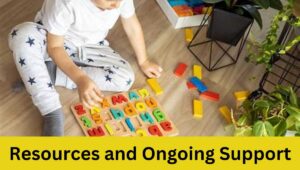
Resources
- Resources are like tools or guides that can help you. They include things like books, websites, articles, and videos that provide information and tips.
Learning Materials
- Resources can also include educational materials or activities that you can use to help yourself or your child learn and grow.
Expert Advice
- Sometimes, you might need advice or answers to your questions. Resources can connect you to experts or knowledgeable people who can help.
Local Support
- You might find support groups or workshops in your community that can provide ongoing help and guidance. These can be valuable for sharing experiences and learning together.
Staying Connected
- Ongoing support means you can keep in touch with these resources and people whenever you need help or have new questions.
Lifelong Learning
- It’s about recognizing that learning and growing as a parent (or in any area of life) is a continuous journey, and resources and support are there to assist you along the way.
Building a Network
- Ongoing support helps you build a network of people who can offer advice, encouragement, and solutions as you navigate your parenting journey.
